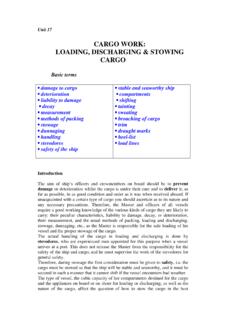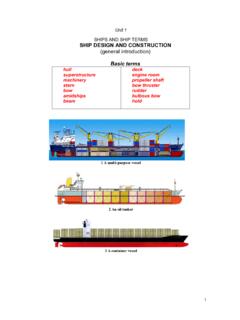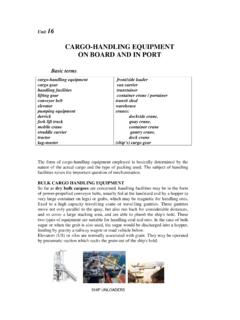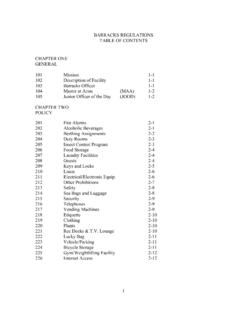Transcription of PORTS AND HARBOURS - UNIRI
1 1 Unit 14 PORTS AND HARBOURS Basic terms port, harbour , haven port structures wharf berth quay pier jetty dock mole breakwater dock basin terminal Port Authority harbour (master s) Office port areas storage facilities port facilities maritime administration bething accommodation dock basin port regulations port facilities port dues PORTS and HARBOURS conduct four important functions: administrative (ensuring that the legal, socio-political and economic interests of the state and international maritime authorities are protected), development ( PORTS are major promoters and instigators of a country s or wider regional economy), industrial (major industries process the goods imported or exported in a port), and commercial ( PORTS are international trade junction points where various modes of transport interchange; loading, discharging, transit of goods).
2 A port is a facility for receiving ships and transferring cargo. They are usually situated at the edge of an ocean, sea, river, or lake. PORTS often have cargo-handling equipment such as cranes (operated by longshoremen) and forklifts for use in loading/unloading of ships, which may be provided by private interests or public bodies. Often, canneries or other processing facilities will be located near by. harbour pilots and tugboats are often used to maneuver large ships in tight quarters as they approach and leave the docks. PORTS which handle international traffic have customs facilities . (Source: Wikipedia) The terms "port" and "seaport" are used for PORTS that handle ocean-going vessels, and "river port" is used for facilities that handle river traffic, such as 2barges and other shallow draft vessels.
3 Some PORTS on a lake, river, or canal have access to a sea or ocean, and are sometimes called "inland PORTS ". A "fishing port" is a type of port or harbor facility particularly suitable for landing and distributing fish. A "dry port" is a term sometimes used to describe a yard used to place containers or conventional bulk cargo, usually connected to a seaport by rail or road. A "warm water port" is a port where the water does not freeze in winter. Because they are available year-round, warm water PORTS can be of great geopolitical or economic interest, with the PORTS of Saint Petersburg and Valdez being notable examples. A "port of call" is an intermediate stop, for example to collect supplies or fuel.
4 Cargo containers allow efficient transport and distribution by eliminating loading of smaller packages at each transportation point, and allowing the shipping unit to be sealed for its entire journey. Standard containers can easily be loaded on a ship, train, truck, or airplane, greatly simplifying intermodal transfers. Cargo often arrives by train and truck to be consolidated at a port and loaded onto a large container ship for international transport. At the destination port, it is distributed by ground transport. The world's busiest port is contested by several PORTS around the world, as there is as yet no standardised means of evaluating port performance and traffic. For the past decade the distinction has been claimed by both the Port of Rotterdam and the Port of Singapore.
5 The former based its measurement on cargo tonnage handled (total weight of goods loaded and discharged), while the latter ranks in terms of shipping tonnage handled (total volume of ships handled). Since 2005, the Port of Shanghai has exceeded both PORTS to take the title in terms of total cargo tonnage. According to Wikipedia, the following PORTS have variously made claims to be largest world port: Port of Shanghai, Port of Singapore, Port of Rotterdam, Port of Hong Kong, Port of New York/New Jersey. 3 Various dictionaries give the following main entries for the word port : a place on a waterway with facilities for loading and unloading ships. a city or town on a waterway with such facilities .
6 The waterfront district of a city. a place along a coast that gives ships and boats protection from storms and rough water; a harbor. In what follows several aspects of PORTS worldwide will be discussed (port structures, port terminals, basic port information, port regulations, etc.). 41. Port structures The terms port, harbour and haven are more or less synonymous, but each of them also has specific meanings. Port layout: Mar del Plata Layout of a port (Scrabster harbour ): port structures A harbour (US spelling "harbor") is a place of security and comfort, a small bay or other sheltered part of an area of water, usually well protected against high waves and strong currents, and deep enough to provide anchorage for ships and other craft.
7 It is also a place where port facilities are provided, accommodation for ships and cargo handling facilities . The term port or seaport normally includes the harbour and the adjacent town or city suitable for loading goods and embarking men. A haven is a type of harbour used in literature or in names and adds the idea of refuge. Ships are accommodated and handled, loaded and unloaded, at such port structures as; wharfs or quays, piers and jetties, and sometimes alongside moles or breakwaters. Any place where a ship can safely lie alongside a quay, pier or dock, at anchor or a buoy, and where she can carry out loading/discharge operations or embark and disembark passengers is called a berth (vez, pristan).
8 A dry dock (suhi dok; remontno brodogradili te) is a type of dock consisting of a rectangular basin dug into the shore of a body of water and provided with a removable enclosure wall or gate on the side toward the water, used for major repairs and overhaul of vessels. 5 When a ship is to be docked, the dry dock is flooded, and the gate removed. Berths and dry docks, Tilbury Wharf ((lu ka) obala) is the oldest term in English referring to port structures. It denotes any structure of timber, masonry, cement, or other material built along or at an angle to the navigable waterway, with sufficient depth of water to accommodate vessels and receive and discharge cargo or passengers.
9 The term can be substituted for quay ((lu ka) obala) when applied to great solid structures in large PORTS . The area between the quay wall (made of solid masonry) and the nearby warehouse or storage facility is ca1led the quay apron. Quay / wharf Quay / wharf A pier (gat) is a construction work extending into the harbour with sufficient depth of water alongside to accommodate vessels, also used as a promenade or landing place for passengers. A jetty (gat) is a small pier, usually made of timbers for boats, yachts or fishing boats (fisherman jetty), but it also refers to large ships (tanker jetty, T-jetty). 6 Oil jetty Oil terminal The term dock (dok; ustava; gat; lu ka obala) has a number of meanings.
10 It is an artificially enclosed basin into which vessels are brought for inspection and repair. A dock is a place, usually man-made area of enclosed water, where ships are loaded, unloaded or repaired. Originally, it denotes an area of water that can accommodate a ship and can be closed off by locks to allow regulation of the water level. It also means a space between two wharves or piers for the mooring of ships, a dock basin. Often it can be interchanged with the terms wharf or pier. In US it often indicates a small landing pier for accommodating boats in a river or lake creek. London docks dock dock dock dock dock basin - Felixtowe 7 Layout of a port port structures (lu ki objekti, lu ka infrastukura): 8 Port Terminals The word terminal refers to a complete port facility for accommodating, loading/ discharge of ships and for the storage, stacking and handling of cargo on shore ( bulk cargo terminal, oil terminal, livestock terminal, etc.)













